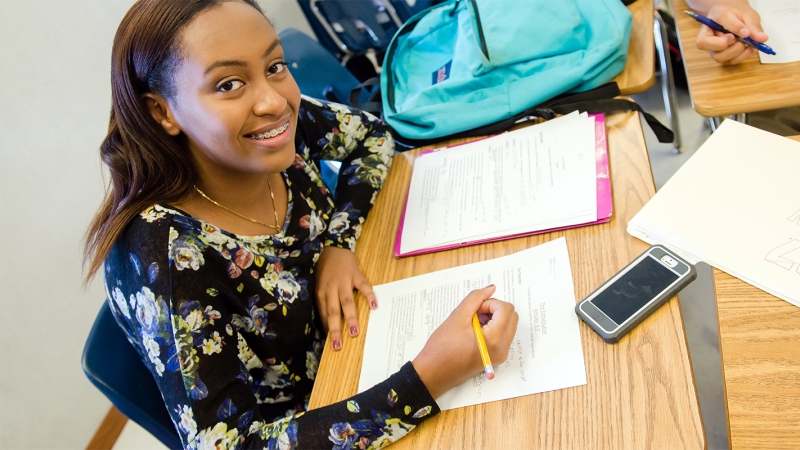
Interventions and Specialized Reading Programs
All students require strong core instruction, but students with dyslexia may require additional instruction through interventions in order to address their particular needs in reading and writing.
FROM INSTRUCTION TO INTERVENTION
Effective literacy instruction is essential for all students but especially for students with dyslexia. Dyslexia occurs on a continuum; as such, instruction is matched to the profile of the reader based on specific needs, as determined by multiple data sources. The needs of some students with dyslexia can be met with intensified core instruction. See “Core Instruction for Students with Dyslexia” for more information.
In FCPS, high-quality core instruction (both elementary and secondary) is paramount and provides a foundation for learning. Access to continued core instruction is an important element of intervention planning.
Many students with dyslexia will require an intervention to build their phonological and word reading skills at some point during their education. An intervention is targeted instruction in an area of difficulty in order to close a gap between current performance and grade level performance. A student does not need to have an Individualized Education Program (IEP) to access an intervention.
Dyslexia results in difficulties with accurate and/or fluent word recognition (decoding) and poor spelling (encoding). Thus, a student with dyslexia may benefit from targeted instruction to address weaknesses in decoding, spelling, reading fluency, and/or writing.
CRITICAL COMPONENTS OF INTERVENTIONS FOR DYSLEXIA
Critical components of evidence-based reading interventions for students with dyslexia may include some or all of the following:
- Phonological Awareness/Phonemic Awareness: Understanding the sound structure of our language; how to recognize, manipulate, blend, and segment individual speech sounds in words
- Phonics/decoding: Linking the graphemes (letters) to the phonemes (sounds); learning the syllable types in our English system and how to divide syllables
- Orthography: Using spelling patterns and rules in our English system (encoding); integrating decoding and encoding
- Reading Fluency: Building strategies to support appropriate rate, accuracy, and expression
- Syntax: Using correct grammar, sentence structure, and mechanics of our language system
- Vocabulary/Morphology: Building words and increasing vocabulary through the study of base words, prefixes, roots, and suffixes
- Reading Comprehension: Using comprehension strategies and metacognitive processes to support getting meaning from text
CONTINUUM OF INTERVENTIONS FOR DYSLEXIA
Dyslexia occurs on a continuum; so, too, should the interventions that serve the needs of students with dyslexia. Targeted interventions in elementary schools may be delivered within the classroom or in an alternate setting, such as a resource room or a literacy lab. In secondary schools, interventions may be delivered during an intervention period or a literacy elective class.
Intervention options for students with dyslexia correspond to the Responsive Instruction tiers. See the section entitled, “Responsive Instruction for Students with Dyslexia” for more information.
Tier 1
All students receive:- Evidence-based, high quality core instruction PLUS
- Differentiated instruction and additional support provided as needed (ex. intensified word study instruction)
Tier 2 - Less Intense
Based on data, some students receive:- Evidence-based, high quality core instruction PLUS
- Small group, targeted intervention (ex. explicit phonics lessons)
Tier 2 - More intense
Based on data, some students receive:
- Evidence-based, high quality core instruction PLUS
- Targeted specialized reading programs (ex. Orton-Gillingham based programs)
Tier 3
Based on data, few students receive:- Evidence-based, high quality core instruction PLUS
- Intensive intervention in areas of need (comprehensive reading programs; Orton-Gillingham based programs with a higher frequency or for a longer duration than Tier 2)
STRUCTURED LITERACY APPROACH
Principles of effective instruction for students with dyslexia are research-based practices that have their foundations in an Orton-Gillingham approach. Included in the approach are the following characteristics:
- Direct and Explicit: Skills are taught in an explicit manner through a gradual release of instruction
- Systematic and Cumulative: A systematic scope and sequence of skills, starting at the beginning to build foundational skills
- Multisensory: Instruction that uses all learning pathways in the brain (visual, auditory, kinesthetic and tactile)
- Cognitive and Language-Based: Building an awareness of our language structure to activate learning
- Data-driven: Continual assessment of student performance to provide feedback to student and guide instruction
SPECIALIZED READING PROGRAMS
If students require targeted or intensive interventions, schools may consider implementing a specialized reading program, also called a structured literacy program. FCPS offers a number of specialized reading programs which have been proven to be effective for students with dyslexia. Both general educators and special educators have access to scheduled training opportunities on these specialized reading programs throughout the year.
The array of reading and writing programs offered by FCPS are presented in this chart. An asterisk on the chart indicates that the program has been proven to have effectiveness for students with dyslexia when delivered with fidelity.
Instructional Matching
One size does not fit all with programs for students with dyslexia. A match must be made between the students’ areas of need and the program that is developed to target that area of need. It is important that families and educators discuss the identified needs and build consensus on the services to address the need. The “Regional Points of Contact for Dyslexia” can help support the process of instructional matching.
Fidelity
In the event that a school team decides to use a specialized reading program to provide intervention for a student with dyslexia, the program should be used with fidelity for maximum efficacy. Fidelity means the program is implemented in the same way as the research indicated the program will be effective according to the publisher. This includes the timing, steps, and materials that come with the program.
There are three important elements of fidelity: frequency, duration, and pacing. Frequency is how often the program is offered. Some programs are effective when used three days a week; others require five days a week. Duration means how many minutes each lesson takes. Most intervention program lessons are 30 or 45 minutes in duration. Many programs will have different recommendations for frequency and duration based on student need. Pacing is the recommended schedule for introduction of each lesson and/or unit of study. Appropriate pacing will enable students to make appropriate progress over the course of several weeks or months of program implementation. IEP Teams determine the amount of services a particular student needs and will require in order to have the program implemented with fidelity.
Progress Monitoring
Monitoring students’ progress by measuring the target phonological awareness, decoding, fluency, and spelling skills at regular intervals is important in ensuring that the specialized reading program continues to be the appropriate instructional match. It is best practice to notify parents and guardians of progress at regular intervals, and of any proposed changes to intervention programming.
Key Components for Successful Interventions
- Student needs are specifically identified; interventions are matched to the underlying skill deficits, and are delivered by a trained professional.
- Instruction is well planned, sequenced, and implemented with fidelity.
- Students improve by building necessary skills/strategies.
- Progress is monitored on the specific skill/strategy and discussed on a consistent basis.
- Communication occurs between the interventionist and all other stakeholders, including families.
- Students continue to receive high quality core instruction.
For information about the tiers of intervention, and interventions in areas besides reading impacted by dyslexia, see the section entitled, “Responsive Instruction for Students with Dyslexia.”
© 2017 Fairfax County School Board. All rights reserved. This material may not be reproduced, displayed, modified or distributed without the express prior written permission of the copyright holder. For permission, contact the FCPS Department of Special Services, Office of Special Education Instruction, Willow Oaks Corporate Center, 8270 Willow Oaks Corporate Drive, Fairfax, VA 22031.





